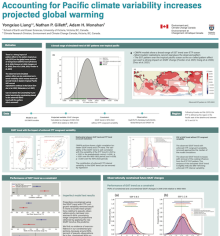Accounting for Pacific climate variability increases projected global warming
Yongxiao
Liang
Climate Research Division, Environment and Climate Change Canada, Victoria, BC, Canada
Poster
Observational constraint methods based on the relationship between the past global warming trend and projected warming across climate models, together with observations of the past warming trend, have been used to narrow the uncertainties in projected warming, including by the Intergovernmental Panel on Climate Change (IPCC). Unforced internal climate variability in the eastern tropical Pacific associated with the so-called pattern effect over the historical period weakens this relationship, and has reduced the observed warming trend over recent decades. Here we show that removing this variability from observed and simulated constraint of past global warming trends enhances the correlation between past warming trends and projected warming across models, and results in higher and narrower observationally-constrained 21st century warming ranges than other methods. Whereas the IPCC assessed that warming is unlikely to exceed 2°C this century under a low emissions scenario, our results indicate that warming is likely to exceed 2°C under the same scenario, and hence that meeting the Paris Agreement goal of limiting global warming to well below 2°C will require even more rapid and deep emissions reductions than previously anticipated. At the same time, since many climate impacts scale with global warming, the substantial narrowing of uncertainty ranges we find will have substantial benefits for adaptation planning.

Poster file
yongxiao-liang-confronting-poster.pdf
(8.35 MB)
